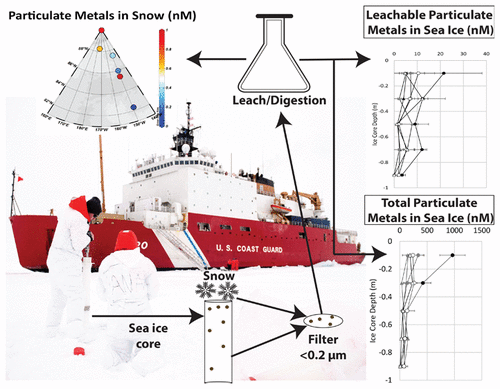当前位置:
X-MOL 学术
›
ACS Earth Space Chem.
›
论文详情
Our official English website, www.x-mol.net, welcomes your
feedback! (Note: you will need to create a separate account there.)
Particulate Trace Metals in Arctic Snow, Sea Ice, and Underlying Surface Waters during the 2015 US Western Arctic GEOTRACES Cruise GN01
ACS Earth and Space Chemistry ( IF 2.9 ) Pub Date : 2020-11-17 , DOI: 10.1021/acsearthspacechem.0c00208 Channing Bolt 1 , Ana Aguilar-Islas 1 , Robert Rember 2
ACS Earth and Space Chemistry ( IF 2.9 ) Pub Date : 2020-11-17 , DOI: 10.1021/acsearthspacechem.0c00208 Channing Bolt 1 , Ana Aguilar-Islas 1 , Robert Rember 2
Affiliation

|
Sea ice, an intrinsic component of the Arctic system, is undergoing rapid change. Sea ice dynamics play a role in the distributions of trace metals in Arctic waters through the incorporation, transport, and release of particles derived from atmospheric, sedimentary, and biological sources. Particulate (>0.2 μm) trace metals (Al, Mn, Fe, Co, Ni, Cu, Zn, Cd, Ba, and Pb) were measured in Arctic pack ice, associated snow, and underlying surface waters collected from September to October 2015 during the US GEOTRACES Western Arctic cruise (GN01). Sampled ice contained low sediment loads, was permeable, and had undergone desalination prior to collection. To assess the lability and refractory nature of particles from snow, sea ice, and underlying surface waters, samples were subjected to an acetic acid leach solution prior to complete digestion. In general, snow particles were of lithogenic origin, with enrichment of Co, Ni, Cu, and Zn at one station in the Canada Basin. Lower than expected particulate metal loads were observed within the sea ice matrix at all stations. Our measurements of the top 1 m of the ice column yielded higher loads for Al, and Fe (88 and 23 μmol m–2, respectively), intermediate loads for Mn, Zn, and Ba (0.82, 0.38, and 0.12 μmol m–2, respectively), and lower loads for Co, Ni, Cu, Cd, and Pb (20, 50, 40, 1, and 20 nmol m–2, respectively). Because sediment-laden “dirty ice” was not sampled during this study, these values likely reflect the lower range of particulate metal loads in Arctic sea ice. To determine heterogeneity at the meter-scale (within station) vs the mesoscale (among stations) multiple cores were collected at each sea ice station. Particulate Al and Fe were the only two metals with a discernible pattern of greater heterogeneity at the mesoscale for the sampled ice. These two metals also showed a distinct atmospheric source, while Cd and Pb appeared to have a source from the surface seawater below the ice. Except for Fe, labile particulate metals were close to, or at, the detection limit. Low leachable particulate metal fractions in snow and sea ice could reflect prior in situ leaching of particles in contact with brine pockets and/or a consequence of procedural artifacts during melting. As multiyear ice becomes less abundant in the Arctic Ocean, the reservoir of particulate metals previously exported to the North Atlantic via sea ice will instead be released within Arctic waters during the melting season, impacting dissolved metal loads and the export of particulate metals.
中文翻译:

2015年美国西部北极GEOTRACES巡洋舰GN01期间,北极雪,海冰和下层地表水中的痕量金属微粒
海冰是北极系统的一个内在组成部分,正在迅速发生变化。通过结合,运输和释放源自大气,沉积和生物来源的颗粒,海冰动力学在北极水中微量金属的分布中发挥着作用。在2015年9月至2015年10月收集的北极冰块,相关积雪和底层地表水中测量了颗粒(> 0.2μm)的痕量金属(Al,Mn,Fe,Co,Ni,Cu,Zn,Cd,Ba和Pb)在美国GEOTRACES西部北极航行(GN01)期间进行。采样的冰含沙量低,可渗透,并且在收集前已进行了脱盐处理。为了评估来自雪,海冰和下层地表水的颗粒的不稳定性和耐火性,在完全消化之前,对样品进行乙酸浸提。通常,雪粒是成岩成因的,加拿大盆地中的一个站点富含Co,Ni,Cu和Zn。在所有台站的海冰基质中均观测到低于预期的颗粒金属负荷。我们对冰柱顶部1 m的测量得出铝和铁的负荷较高(88和23μmolm分别为–2),Mn,Zn和Ba的中间负荷(分别为0.82、0.38和0.12μmolm –2),以及Co,Ni,Cu,Cd和Pb的较低负荷(20、50、40 ,1和20 nmol m –2, 分别)。由于在此研究中未采样到充满泥沙的“脏冰”,因此这些值可能反映了北极海冰中较低的颗粒金属负荷范围。为了确定米级(站内)与中尺度(站间)的异质性,在每个海冰站收集了多个岩心。颗粒状的Al和Fe是仅有的两种金属,在中尺度上对采样的冰具有更大的异质性。这两种金属还显示出独特的大气来源,而Cd和Pb似乎来自冰下的表层海水。除铁之外,不稳定的颗粒金属均接近或处于检测极限。雪和海冰中可浸出的低颗粒金属分数可能反映了原位与盐水袋接触的颗粒浸出和/或融化过程中程序伪像的结果。随着北冰洋多年生冰的减少,以前通过海冰出口到北大西洋的颗粒状金属的储集层将在融化季节期间在北极水域内释放,从而影响溶解的金属负载和颗粒状金属的出口。
更新日期:2020-12-17
中文翻译:

2015年美国西部北极GEOTRACES巡洋舰GN01期间,北极雪,海冰和下层地表水中的痕量金属微粒
海冰是北极系统的一个内在组成部分,正在迅速发生变化。通过结合,运输和释放源自大气,沉积和生物来源的颗粒,海冰动力学在北极水中微量金属的分布中发挥着作用。在2015年9月至2015年10月收集的北极冰块,相关积雪和底层地表水中测量了颗粒(> 0.2μm)的痕量金属(Al,Mn,Fe,Co,Ni,Cu,Zn,Cd,Ba和Pb)在美国GEOTRACES西部北极航行(GN01)期间进行。采样的冰含沙量低,可渗透,并且在收集前已进行了脱盐处理。为了评估来自雪,海冰和下层地表水的颗粒的不稳定性和耐火性,在完全消化之前,对样品进行乙酸浸提。通常,雪粒是成岩成因的,加拿大盆地中的一个站点富含Co,Ni,Cu和Zn。在所有台站的海冰基质中均观测到低于预期的颗粒金属负荷。我们对冰柱顶部1 m的测量得出铝和铁的负荷较高(88和23μmolm分别为–2),Mn,Zn和Ba的中间负荷(分别为0.82、0.38和0.12μmolm –2),以及Co,Ni,Cu,Cd和Pb的较低负荷(20、50、40 ,1和20 nmol m –2, 分别)。由于在此研究中未采样到充满泥沙的“脏冰”,因此这些值可能反映了北极海冰中较低的颗粒金属负荷范围。为了确定米级(站内)与中尺度(站间)的异质性,在每个海冰站收集了多个岩心。颗粒状的Al和Fe是仅有的两种金属,在中尺度上对采样的冰具有更大的异质性。这两种金属还显示出独特的大气来源,而Cd和Pb似乎来自冰下的表层海水。除铁之外,不稳定的颗粒金属均接近或处于检测极限。雪和海冰中可浸出的低颗粒金属分数可能反映了原位与盐水袋接触的颗粒浸出和/或融化过程中程序伪像的结果。随着北冰洋多年生冰的减少,以前通过海冰出口到北大西洋的颗粒状金属的储集层将在融化季节期间在北极水域内释放,从而影响溶解的金属负载和颗粒状金属的出口。











































 京公网安备 11010802027423号
京公网安备 11010802027423号